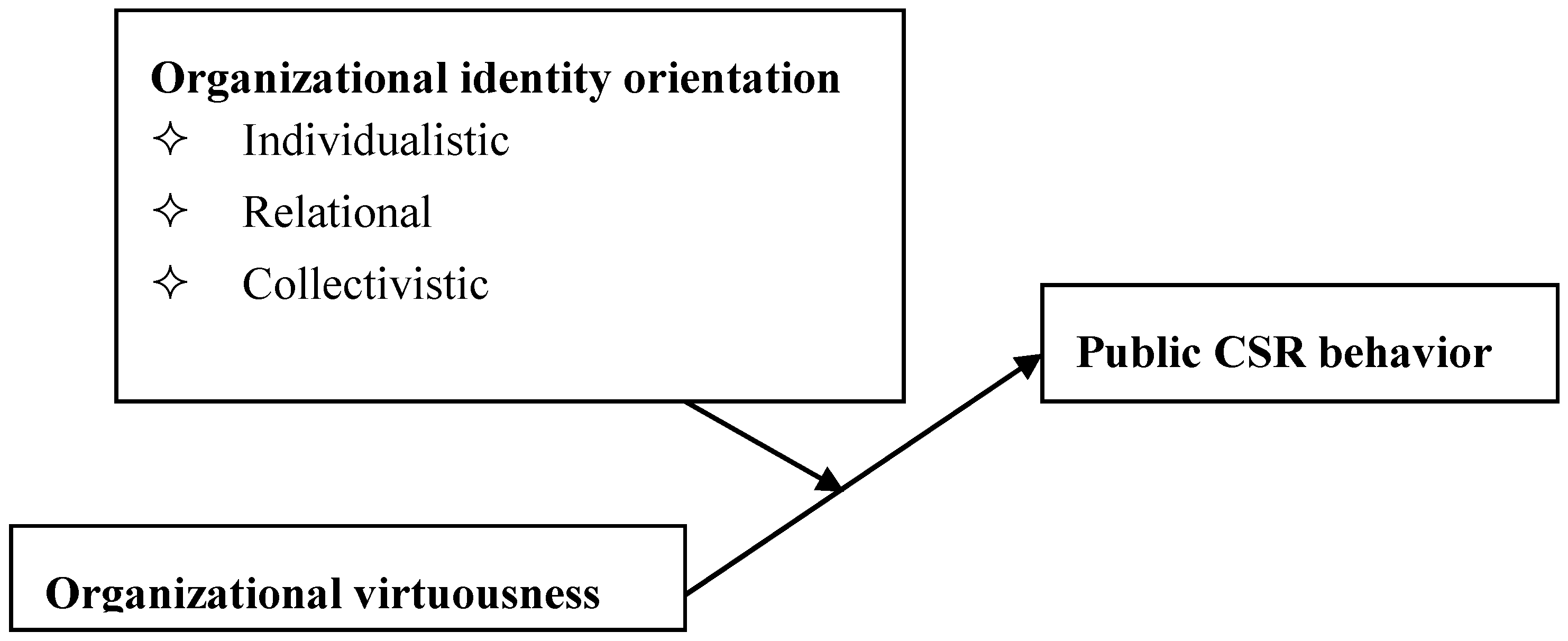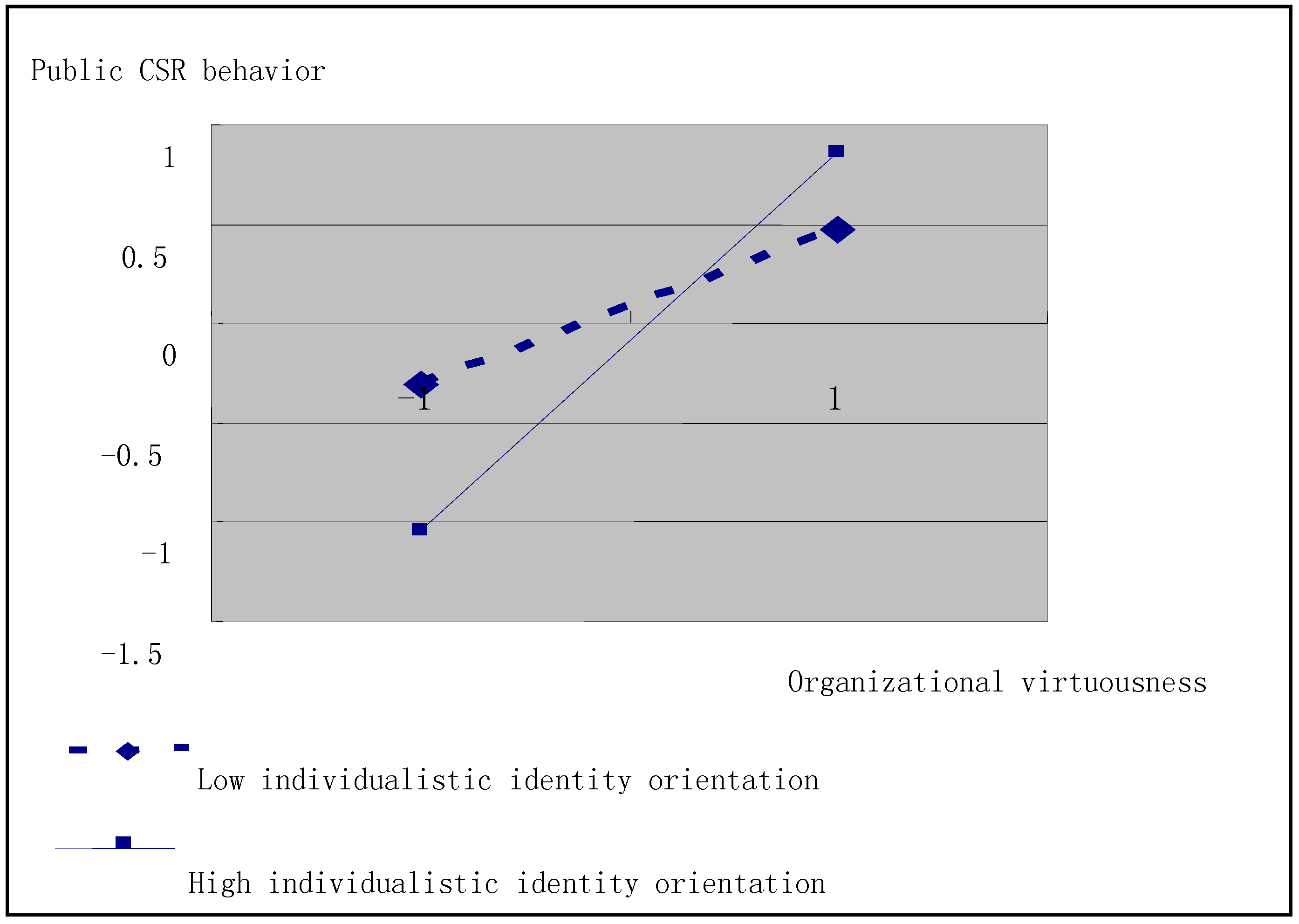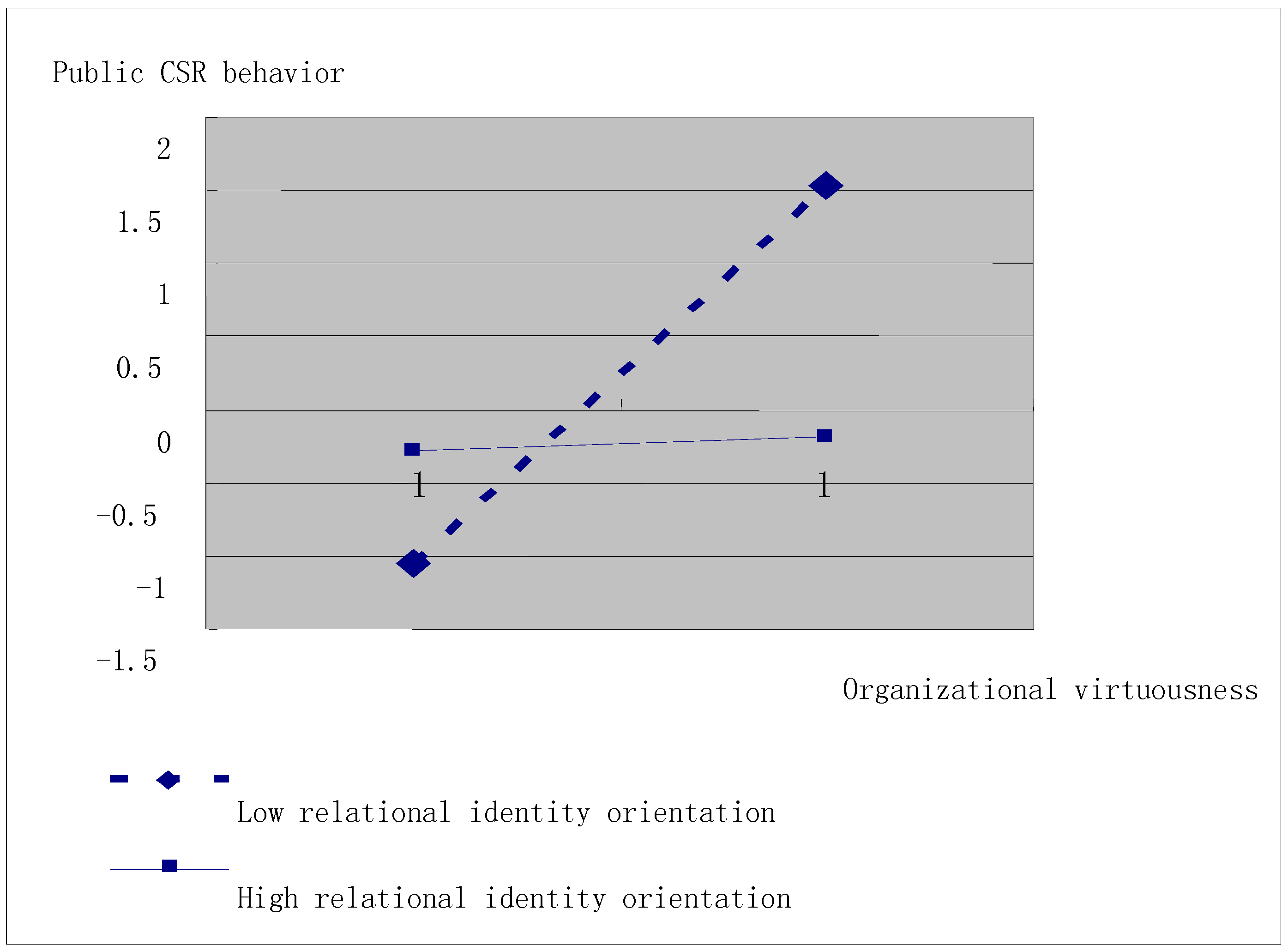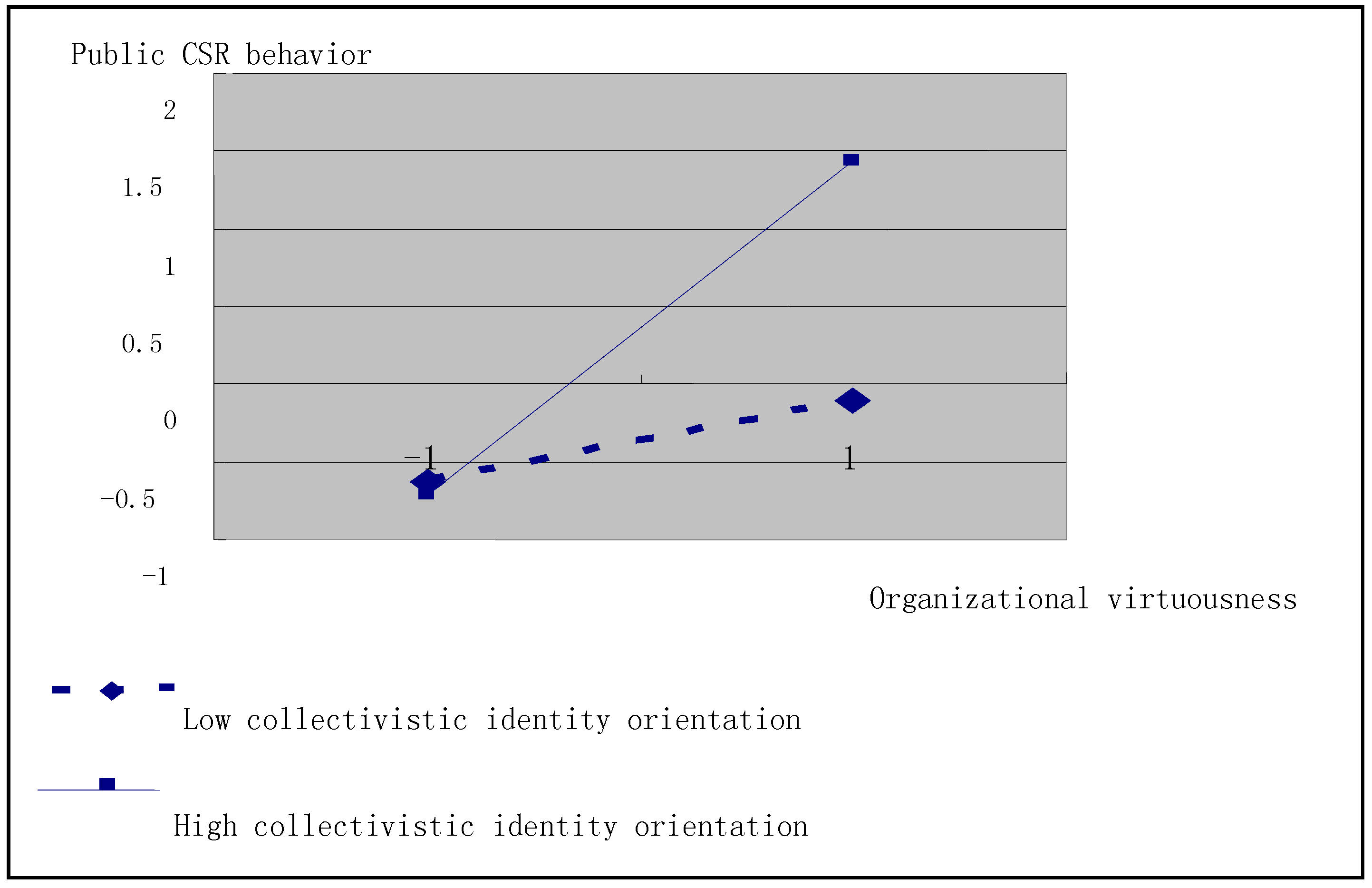Why Are Corporations Willing to Take on Public CSR? An Organizational Traits Approach
Abstract
:1. Introduction
2. Theoretical Framework and Hypotheses
2.1. Theoretical Framework
2.2. Hypothesis
3. Method
3.1. Samples
3.2. Measures
4. Results
4.1. Data Verification Analysis
4.2. Aggregate Analyses
4.3. Descriptive Statistics and Correlation Analysis
4.4. Hypothesis Testing
5. Discussion
5.1. Conclusions
5.2. Managerial Implications
5.3. Theoretical Implications
5.4. Limitations
5.5. Future Directions
Author Contributions
Funding
Conflicts of Interest
References
- Foreman, P.; Whetten, D.A. Members’ identification with multiple identity organizations. Organ. Sci. 2002, 13, 618–635. [Google Scholar] [CrossRef]
- Clarkson, M.E. A stakeholder framework for analyzing and evaluating corporate social performance. Acad. Manag. Rev. 1995, 20, 92–117. [Google Scholar] [CrossRef]
- Charkham, J. Corporate Governance: Lessons from Abroad. Eur. Bus. J. 1992, 4, 8–16. [Google Scholar]
- Gardberg, N.A.; Fombrun, C.J. Corporate citizenship: Creating intangible assets across institutional environment. Acad. Manag. Rev. 2006, 31, 329–346. [Google Scholar] [CrossRef]
- Albareda, L.; Lozano, J.M.; Ysa, T. Public policies on corporate social responsibility: The role of governments in Europe. J. Bus. Ethics 2007, 74, 391–407. [Google Scholar] [CrossRef]
- Wang, H.L.; Tong, L.; Takeuchi, R.; George, G. Corporate social responsibility: An overview and new research directions. Acad. Manag. J. 2016, 59, 534–544. [Google Scholar] [CrossRef]
- Aguilera, R.V.; Rupp, D.E.; Ganapathi, W.J. Putting the S Back in Corporate Social Responsibility: A Multilevel Theory of Social Change in Organizations. Acad. Manag. Rev. 2007, 32, 836–863. [Google Scholar] [CrossRef]
- Li, J.; Tang, G.; Chen, Y. Firms’ human resource in information system and sustainable performance: Does their organizational identity matter? Int. J. Hum. Resour. Manag. 2012, 23, 3838–3855. [Google Scholar] [CrossRef]
- Pfeffer, J.; Salancik, G.R. The External Control of Organizations: A Resource Dependence Perspective; Harper & Row: New York, NY, USA, 1978. [Google Scholar]
- Porter, M.E.; Kramer, M.R. The competitive advantage of corporate philanthropy. Harv. Bus. Rev. 2002, 80, 56–69. [Google Scholar]
- Godfrey, P. The relationship between corporate philanthropy and shareholder wealth: A risk management perspective. Acad. Manag. Rev. 2005, 30, 777–798. [Google Scholar] [CrossRef]
- Meyer, J.W.; Rowan, B. Institutionalized organizations: Formal structure as myth and ceremony. Am. J. Sociol. 1977, 83, 340–363. [Google Scholar] [CrossRef]
- Campbell, J.L. Why would corporations behave in socially responsible ways? An institutional theory of corporate social responsibility. Acad. Manag. Rev. 2007, 32, 946–967. [Google Scholar] [CrossRef]
- Mahoney, J.T.; Huff, A.S.; Huff, J.O. Towards a new social contract theory in organization science. J. Manag. Inq. 1994, 3, 153–168. [Google Scholar] [CrossRef]
- Logsdon, J.M.; Wood, D.J. Business citizenship: From domestic to global level of analysis. Bus. Ethics Q. 2002, 12, 155–187. [Google Scholar] [CrossRef]
- Fort, T.L. A review of Donaldson and Dunfee’s “Ties that bind: A social contracts approach to business ethics”. J. Bus. Ethics 2000, 28, 383–387. [Google Scholar] [CrossRef]
- Arjoon, S. Virtue theory as a dynamic theory of business. J. Bus. Ethics 2000, 28, 159–178. [Google Scholar] [CrossRef]
- van de Ven, B. An ethical framework for the marketing of corporate social responsibility. J. Bus. Ethics 2008, 82, 339–352. [Google Scholar] [CrossRef]
- Bright, D.S. Virtuousness is necessary for genuineness in corporate philanthropy. Acad. Manag. Rev. 2006, 31, 752–756. [Google Scholar] [CrossRef]
- Bingham, J.B.; Gibb Dyer, W., Jr.; Smith, I.; Adams, G.L. A stakeholder identity orientation approach to corporate social performance in family firms. J. Bus. Ethics 2011, 99, 565–585. [Google Scholar] [CrossRef]
- Basu, K.; Palazzo, G. Corporate social responsibility: A process model of sense-making. Acad. Manag. Rev. 2008, 33, 122–136. [Google Scholar] [CrossRef]
- Brickson, S.L. Organizational identity orientation: Forging a link between organizational identity and organizations’ relations with stakeholders. Adm. Sci. Q. 2005, 50, 576–609. [Google Scholar] [CrossRef]
- Sison, A.J.G.; Ferrero, I. How different is neo-Aristotelian virtue from positive organizational virtuousness? Bus. Ethics Eur. Rev. 2015, 24, 78–98. [Google Scholar] [CrossRef]
- Murphy, P.E. Character and virtue ethics in international marketing: An agenda for managers, researchers and educators. J. Bus. Ethics 1999, 18, 107–124. [Google Scholar] [CrossRef]
- Moore, G.; Beadle, R. In search of organizational virtue in business: Agents, goods, practices, institutions and environments. Organ. Stud. 2006, 27, 369–389. [Google Scholar] [CrossRef]
- O’Mara-Shimek, M.; Guillén, M.; BanonGomis, A.J. Approaching virtuousness through organizational ethical quality: Toward a moral corporate social responsibility. Bus. Ethics Eur. Rev. 2015, 24, 144–155. [Google Scholar] [CrossRef]
- Nikandrou, I.; Tsachouridi, I. Towards a better understanding of the “buffering effects” of organizational virtuousness’ perceptions on employee outcomes. Manag. Decis. 2015, 53, 1823–1842. [Google Scholar] [CrossRef]
- Cameron, K.; Winn, B. Virtuousness in organizations. In The Oxford Handbook of Positive Organizational Scholarship; Cameron, K.S., Spreitzer, G.M., Eds.; Oxford University Press: New York, NY, USA, 2012; pp. 231–243. [Google Scholar]
- Cameron, K.S.; Bright, D.; Caza, A. Exploring the relationships between virtuousness and performance. Am. Behav. Sci. 2004, 47, 766–790. [Google Scholar] [CrossRef]
- Bright, D.S.; Cameron, K.S.; Caza, A. The amplifying and buffering effects of virtuousness in downsized organizations. J. Bus. Ethics 2006, 64, 249–269. [Google Scholar] [CrossRef]
- Bright, D.S.; Winn, B.A.; Kanov, J. Reconsidering virtue: Differences of perspective in virtue ethics and the positive social sciences. J. Bus. Ethics 2014, 119, 445–460. [Google Scholar] [CrossRef]
- Sadler-Smith, E. Before Virtue: Biology, Brain, Behavior, and the Moral sense. Bus. Ethics Q. 2012, 22, 351–376. [Google Scholar] [CrossRef]
- Brewer, M.B.; Gardner, W. Who is this “we”? Levels of collective identity and self-representations. J. Personal. Soc. Psychol. 1996, 71, 83–93. [Google Scholar] [CrossRef]
- Brickson, S.L. The impact of identity orientation on individual and organizational outcomes in demographically diverse settings. Acad. Manag. Rev. 2000, 25, 82–101. [Google Scholar] [CrossRef]
- Brickson, S. Organizational identity orientation: The genesis of the role of the firm and distinct forms of social value. Acad. Manag. Rev. 2007, 32, 864–888. [Google Scholar] [CrossRef]
- Turker, D. How corporate social responsibility influences organizational commitment. J. Bus. Ethics 2009, 89, 189–204. [Google Scholar] [CrossRef]
- James, L.R.; Demaree, R.G.; Wolf, G. Estimating within-group interrater reliability with and without response bias. J. Appl. Psychol. 1984, 69, 85–98. [Google Scholar] [CrossRef]
- Wang, S. Avenue of Course: Me and Vanke; CITIC Publishing: Beijing, China, 2014. [Google Scholar]
- Moore, G. The virtue of governance, the governance of virtue. Bus. Ethics Q. 2012, 22, 293–318. [Google Scholar] [CrossRef]
- Atkinson, L.; Galaskiewicz, J. Stock ownership and company contributions to charity. Adm. Sci. Q. 1988, 33, 82–100. [Google Scholar] [CrossRef]
- Searle, T.P.; Barbuto, J.E., Jr. Servant Leadership, Hope, and Organizational Virtuousness: A Framework Exploring Positive Micro and Macro Behaviors and Performance Impact. J. Leadersh. Organ. Stud. 2011, 18, 107–117. [Google Scholar] [CrossRef]
- Barbuto, J.E.; Wheeler, D.W. Scale development and construct clarification of servant leadership. Group Organ. Manag. 2006, 31, 300–326. [Google Scholar] [CrossRef]




| Optimism We are optimistic that we will succeed, even when faced with major challenges. In this organization, we are dedicated to doing good in addition to doing well. A sense of profound purpose is associated with what we do here. |
| Trust Employees trust one another in this organization. People are treated with courtesy, consideration, and respect in this organization. People trust the leadership of this organization. |
| Compassion Acts of compassion are common here. This organization is characterized by many acts of concern and caring for other people. Many stories of compassion and concern circulate among organization members. |
| Integrity This organization demonstrates the highest levels of integrity. This organization would be described as virtuous and honorable. Honesty and trustworthiness are hallmarks of this organization. |
| Forgiveness We try to learn from our mistakes here, consequently, missteps are quickly forgiven. This is a forgiving, compassionate organization in which to work. We have very high standards of performance, yet we forgive mistakes when they are acknowledged and corrected. |
| Individualistic orientation My organization views itself primarily as distinct and standing apart from other organizations. What is most important to my organization is working to promote and maintain its own welfare (e.g., profitability, image, etc.). My organization is most concerned about its distinctiveness from other organizations. |
| Relational orientation My organization views itself primarily as a good partner to those with whom it interacts (e.g., employees, customers, nonprofit organizations). What is most important to my organization is working to improve the welfare of particular others with whom the organization has significant and gratifying relationships (e.g., employees, customers, nonprofit organizations). My organization is most concerned about its relationships with particular others whose welfare it values (e.g., employees, customers, a nonprofit organization). |
| Collectivistic orientation My organization views itself primarily as a good member to a larger community (all those with whom it interacts, as a common group; a group of organizations promoting a cause it cares about; local community; etc.). What is most important to my organization is working to improve the welfare of a community it values and/or belongs to (e.g., all those with whom it interacts, as a common group; a group of organizations promoting a cause; local community; etc.). My organization is most concerned about its relationship with a greater community it values and/or belongs to (e.g., all those with whom it interacts, as a common group; a group of organizations promoting a cause it cares about; local community; etc.). |
| Our company participates to the activities which aim to protect and improve the quality of the natural environment. Our company makes investment to create a better life for the future generations. Our company implements special programs to minimize its negative impact on the natural environment. Our company targets a sustainable growth which considers to the future generations. Our company supports the non-governmental organizations working in the problematic areas. Our company contributes to the campaigns and projects that promote the well-being of the society. |
| Variables | Mean | SD | 1 | 2 | 3 | 4 | 5 | 6 | 7 | |
|---|---|---|---|---|---|---|---|---|---|---|
| 1. corporation age | 2.470 | 0.898 | 1 | |||||||
| 2. corporation size | 2.572 | 0.758 | 0.516 ** | 1 | ||||||
| 3. organizational virtuousness | 3.890 | 0.597 | −0.117 | −0.075 | 1 | |||||
| Organizational identity orientation | 4. individualistic | 3.631 | 0.503 | −0.196 | 0.010 | 0.692 ** | 1 | |||
| 5. relational | 3.910 | 0.594 | −0.054 | 0.015 | 0.838 ** | 0.744 ** | 1 | |||
| 6. collectivistic | 3.918 | 0.551 | 0.000 | 0.162 | 0.742 ** | 0.804 ** | 0.833 ** | 1 | ||
| 7. Public CSR behavior | 3.757 | 0.634 | 0.013 | 0.172 | 0.726 ** | 0.557 ** | 0.636 ** | 0.647 ** | 1 | |
| Model | Model 1 | Model 2 | Model 3 | Model 4 | |
|---|---|---|---|---|---|
| Predictors and Outcomes | Public CSR | Public CSR | Public CSR | Public CSR | |
| Beta | Beta | Beta | Beta | ||
| Corporation age | −0.103 | −0.024 | −0.017 | −0.001 | |
| Corporation size | 0.225 | 0.240 ** | 0.202 * | 0.154 | |
| Organizational virtuousness | 0.741 *** | 0.674 *** | 0.670 *** | ||
| Organizational identity orientation | Individualistic | 0.000 | −0.086 | ||
| Relational | −0.091 | −0.235 | |||
| Collectivistic | 0.189 | 0.365 ** | |||
| Organizational virtuousness × Individualistic identity orientation | 0.280 * | ||||
| Organizational virtuousness × Relational identity orientation | −0.622 *** | ||||
| Organizational virtuousness × Collectivistic identity orientation | 0.405 ** | ||||
| F | 1.640 | 38.397 | 19.303 | 19.412 | |
| F significance | 0.200 | 0.000 | 0.000 | 0.000 | |
| Adjusted R2 | 0.015 | 0.563 | 0.558 | 0.656 | |
| ΔR2 | 0.037 | 0.541 | 0.010 | 0.103 | |
| ΔF significance | 0.200 | 0.000 | 0.575 | 0.000 | |
© 2019 by the authors. Licensee MDPI, Basel, Switzerland. This article is an open access article distributed under the terms and conditions of the Creative Commons Attribution (CC BY) license (http://creativecommons.org/licenses/by/4.0/).
Share and Cite
Liu, Y.; Wang, G.G.; Chen, Y. Why Are Corporations Willing to Take on Public CSR? An Organizational Traits Approach. Sustainability 2019, 11, 524. https://doi.org/10.3390/su11020524
Liu Y, Wang GG, Chen Y. Why Are Corporations Willing to Take on Public CSR? An Organizational Traits Approach. Sustainability. 2019; 11(2):524. https://doi.org/10.3390/su11020524
Chicago/Turabian StyleLiu, Yun, Greg. G. Wang, and Yu Chen. 2019. "Why Are Corporations Willing to Take on Public CSR? An Organizational Traits Approach" Sustainability 11, no. 2: 524. https://doi.org/10.3390/su11020524
APA StyleLiu, Y., Wang, G. G., & Chen, Y. (2019). Why Are Corporations Willing to Take on Public CSR? An Organizational Traits Approach. Sustainability, 11(2), 524. https://doi.org/10.3390/su11020524




